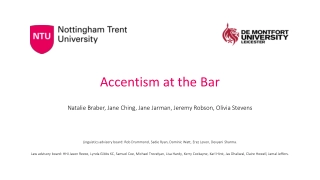Impact of Middle Eastern Accent on Employability
Strong accents can influence job prospects, especially in high-status roles. Stereotypes and biases associated with accents often impact employability, highlighting the need for better understanding and support for nonnative speakers. The study explores how accents affect credibility, career advancement, and the glass ceiling effect in various fields.
Download Presentation

Please find below an Image/Link to download the presentation.
The content on the website is provided AS IS for your information and personal use only. It may not be sold, licensed, or shared on other websites without obtaining consent from the author.If you encounter any issues during the download, it is possible that the publisher has removed the file from their server.
You are allowed to download the files provided on this website for personal or commercial use, subject to the condition that they are used lawfully. All files are the property of their respective owners.
The content on the website is provided AS IS for your information and personal use only. It may not be sold, licensed, or shared on other websites without obtaining consent from the author.
E N D
Presentation Transcript
The Possible Effects of a Middle Eastern Accent on Employability EILEEN FINN CONCORDIA UNIVERSITY
Problem of practice Strong accents can hinder a person s chance for high-status positions in certain fields.
Relevance Stereotypes regarding ethnicity are enforced with strong accents. Nonnative speakers with strong accents are not discriminated against when concerned with low-status jobs and manual labor. However, when it concerns high-status employment or jobs that require good communication skills, accents becomes a more prominent factor. Some accents are actually preferred and can help rather than hinder in regards to employability.
Current actions Many ESL teachers are teaching pronunciation towards the intelligibility model and not the inner-circle model. The majority of immigrants have requested the inner-circle model but their requests are being ignored. AUniversity has merged their ESL department with the Speech-Language Pathology department and the program has been quite successful.
Lit review Foreign accents, intelligibility and Comprehensibility Strong accents rate high in intelligibility, but low in comprehensibility. Some people are able to adjust to accents within a minute and it takes others a long time to adjust. There are two hypotheses: - The Perceptual Distance Hypothesis - The Different Process Hypothesis Middle Easterners have the mildest accents in regards to comprehensibility and intelligibility.
Glass Ceiling Effect Nonnative speakers excel in certain fields. However, in regards to high-status positions, nonnative speakers do not fair well because there is a presumed lack of good communication and leadership skills in medical, higher education, science and engineering and business. Stereotypes and Accents: An accent is the most salient social marker and indicates a speaker s origin, ethnicity and socio-economic status. Accents can evoke strong stereotypes There is a correlation between social cues and stereotypes rather than visual cues and stereotypes
A Question of Credibility Strong accents affect credibility in a negative way. Credibility could be affected by processing time of strong accents. Credibility in Business: Foreign accented speech could be viewed negatively in the field of business as it affects credibility, which have a negative outcome for relationships.
Employability and Accents: Accents provoke stereotypes which could work for or against a nonnative applicant, which is position and field dependent. Issue of Identity Accents can be associated with assimilation. Accents can be tied close to one s identity and culture Identities are fluid, not solid. There are 6 stages to shifting culture and an accent towards the nonnative speakers L2.
Perceived Loyalty Certain ethnic groups perceive a lack of loyalty if a person in their community does not have an accent conducive to their L2. Some ethnic groups are not concerned about accents Certain ethnic groups want to keep their accent to distinguish themselves from other ethnic groups.
On the Outside The discrimination of accents is not a hierarchy, but more of a triangulation that runs along two axes. Superior vs. inferior Foreigner vs. insider Stereotypes are influenced by sociopolitical and affective factors. Different ethnic groups experience discrimination differently which can cause unfair treatment, racial tensions between minority groups, isolation and socio-affective factors.
Middle Eastern Stereotypes They are seen as more competent than Hispanics but not as much as Asians and Europeans They are seen as more foreign than Europeans and Asians, but not as much as Hispanics They are seen as more financially wealthy than Europeans, Asians and Hispanics They are seen as more violent than Asians and Europeans but not as much as Hispanics Inner-Circle Model vs. Intelligibility Model Teachers are currently not teaching to the inner-circle model. 23% of teachers don t teach pronunciation 86% of teachers spend 6% of classroom time on pronunciation Many teachers don t feel competent in teaching pronunciation and lack training Most students want the inner-circle model
Example of methods section following questions This study is based on a prior study conducted by Carlson and McHenry (2006). The study measures comprehensibility and employability in regards to the varying degrees of accents of Middle Easterners. However, this study will differ in that only Middle Eastern males will be looked at in a high-status position in the field of business The methods used will be an experimental blind study using quantitative data collected by surveying 57 employees who work in various Human Resource departments in the states of Oregon, Washington and California.
Research Questions 1. Is the mild-accented Middle Eastern accent perceived as more comprehensible than a strong Middle Eastern-accented applicant? 2. Is the mild-accented Middle Eastern accent perceived as more employable than a strong Middle Eastern-accented applicant?
Study Design Experimental Component oTwo men between the ages of 25 to 35 years of age were selected to create a 29 to 30- second speech samples in 2 degrees of accents (i.e. mild, strong) regarding why they should be chosen for a job. The voice samples were verified by an experienced sound engineer with more than ten years experience. oThe subjects are native speakers from the Middle East. One had a mild accent, while the other one had a strong accent, which was verified by a certified speech pathologist with more than 10 years experience.
Study Design oDefined minimal accents as having phonetic markers that differ from SAE that range from 8% to 10%. Strong accents have phonetic markers that differ from 17% to 22%. Thus, the degree of accents will be referred to in these terms. oListeners who work in the HR dept. filled out a 7-point Likert scales on surverymonkey.com. They were surveyed regarding the following iof each applicant: oComprehensibility oEmployability
District Demographics The sample group is completely anonymous. Experience, gender, educational background, ethnicity and exposure to language was not controlled for authentic population is key in this study.
Treatment Sample Fifty-seven volunteers who work in an HR department who generally employ people in sales. These volunteers were approached via HR associations, university alumni associations, and societies via emails, announcements and newsletters.
Treatment oParticipants listened to the two recordings and were given an unlimited amount of time to rate on a 7-point Likert scale on comprehensibility o1 = very difficult to understand; 7 = very easy to understand oThey will also be measuring for employability on a 7 -point Likert scale 1= most likely to employ; 7 = least likely to employ oParticipants were told that both applicants were equally qualified for the positions and were between the ages of 25 to 35 to ensure there were no biases.
Predictor Variables oThe independent variables were the following: degrees of accents and field of employment. oGender, ethnicity, field of employment and age were controlled variables.
Dependent Measure The dependent variables were employability and comprehensibility.
Statistical Analysis A Pearson s Chi-Square was used to assess whether the expected values of comprehensibility and employability within the varying degrees of accent differ from each other in regards to employability
Results oIn regards to comprehensibility, the chi-square statistic was 40.1589. It had a p-value of <0.00001.The result was significant at p < 0.05. The null hypothesis was rejected. The mild accented speaker was understood far better than the strong accented speaker. o In regards to employability, the chi-square statistic is 19.0498. The p < value is 0.000768. The result is significant at p < 0.05. The null hypothesis was rejected. Mild accented speaker was more employable than the strong accented speaker. o Frequencies 1 & 2 and 6 & 7 were grouped together to equal 5 groups. Thus the degrees of freedom is 4. o There is a significant correlation between comprehensibility and employability.
Graphs Comprehensibility Results 1/2 3 4 5 6/7 Row Totals Strong 0 (6.50) [6.50] 4 (4.50) [0.06] 0 (4.00) [4.00] 5 (9.50) [2.13] 48 (32.50) [7.39] 57 Mild 13 (6.50) [6.50] 5 (4.50) [0.06] 8 (4.00) [4.00] 14 (9.50) [2.13 17 (32.50) [7.39] 57 ] Column Totals 13 9 8 19 65 114 (Grand Totals)
Graphs Employability Results 1/2 3 4 5 6/7 Row Totals Strong 0 (4.50) [4.50] 2 (6.00) [2.67] 9 (9.50) [0.03] 9 (8.00) [0.12] 37 (29.0) [2.21] 57 10 (6.00) [2.67] 10 (9.50) [0.03] 7 (8.00) [0.12] 21 (29.0) [2.21] Mild 9 (4.50) [4.50] 57 Total Columns 9 12 19 16 58 114 (Grand Total)
Results for Comprehensibility: Percentage Values 1/2 3 4 5 6/7 Row Totals Mild 0% 7% 0% 8.8% 84.2% 57 Strong 22.8% 8.8% 14% 24.6% 29.8% 57 Column Totals 13 9 8 29 65 114 (Grand Totals
Results for Employability: Percentage Values 1/2 3 4 5 6/7 Row Totals Mild 0% 3.5% 15.8% 15.8% 65% 57 Strong 15.8% 17.5% 17.5% 12.3% 36.8% 57 Column Totals 9 12 19 16 58 114 (Grand Totals)
Graph 1: Comprehensibility 35 30 25 20 15 10 5 0 1 2 3 4 5 6 7 Mild Strong
Graph 2: Employability 25 20 15 10 5 0 1 2 3 4 5 6 7 Mild Strong
Study Limitations oGender may affect the outcomes. oThe Hawthorne Effect o Voice-guise technique runs being judged on other things other than accents
Discussion & Conclusion oThe Strong-accented Middle Eastern applicant had mixed results oPrior exposure to the accent oHalo effect oStereotypes Most studies re: comprehensibility and employability have had similar results. Social attractiveness re: accents have had mixed results but never questioned employability
oThe persons ethnicity does not affect employability if the person has a mild accent oA Middle Eastern male with a mild accent has a higher chance of employability than one with a strong accent. oHR employees were specifically chosen to enhance real world applicability oThe study was blind to also enhance real world applicability oHigher levels of employment were chosen as lower levels of employment have no bias in regards to accent.
Future Implications oMore studies need to be done in regards to Middle Eastern accents specifically. oMore studies need to be done in regards to varying degrees of Middle Eastern accent in regards to perceived loyalty in their group. o When comparing employability and comprehensibility, more ethnicities needed to be added. oMore accent modification programs, such as PSU s, could be possible at other schools and universities in the future as there is a high demand.
Thank You Eileen Finn Concordia University























